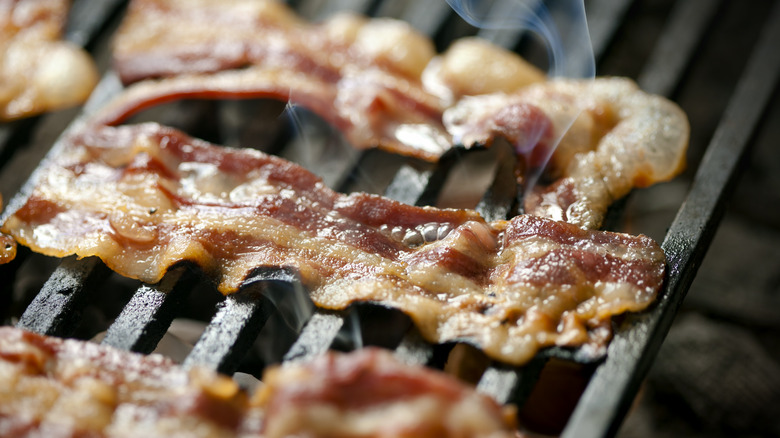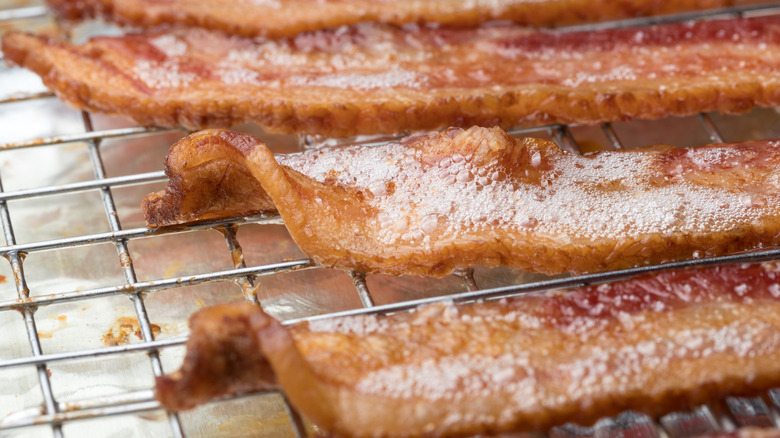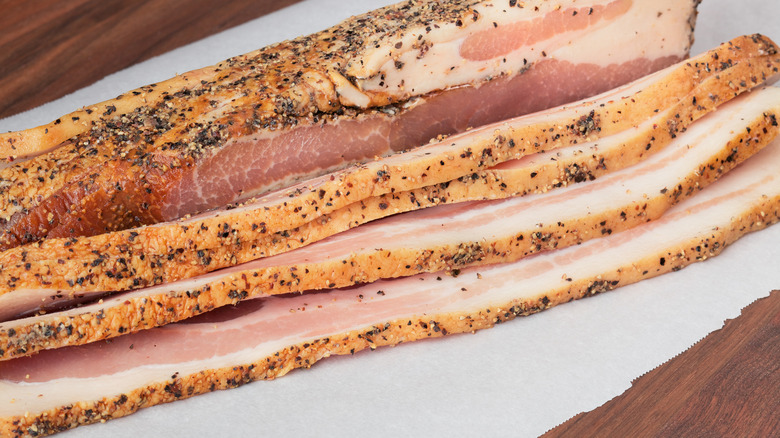Elevate Your Bacon This Summer And Throw It On The Grill
Nothing elevates a grilled burger like a couple of slices of savory bacon. But bacon can also be a pain to cook outdoors. Preparing these meaty strips in the oven or giving your bacon a cold start on a stovetop requires running between the kitchen and the grill. Moreover, in the dog days of summer, heating up your kitchen is far from ideal. The good news is that if you plan ahead carefully, you can cook bacon right next to your burgers and spare yourself trouble and the risk of overheating.
The most intuitive way to cook bacon outdoors is over direct heat, same as your burgers. Lubricate the grates with canola or vegetable oil so the strips don't stick, then preheat the unit to 325 degrees Fahrenheit. Carefully place the strips perpendicular to the bars so you don't lose any through the spaces between them. Once you notice the bacon curling up a bit — after about three to four minutes – flip it using long-handled tongs and cook for another minute or two, depending on how crispy you like it. This process demands a watchful eye: Grilling fatty meats over direct heat can cause flare-ups, which is both a safety hazard and the easiest way to ruin your bacon. However, if this seems a bit intimidating, there are some more forgiving grilling tactics you can employ.
Grilling bacon slower and safer
Once your grill is hot, place the bacon on the cooler side of the grates the same way you put it over direct heat before closing the lid. You might even consider only igniting half of your burners to create two-zones of heat on your grill, and not let them cook too quickly. Remember to flip the strips halfway through so both sides take on a golden-brown color, and either shift to the cooler side or pull them off early if you prefer something more tender.
You can also opt to use a baking sheet for assistance.Line the sheet with aluminum foil for easy cleanup and place a cooling rack on top. Warm the grill to medium-low heat and place the baking sheet directly over the grates. The heat will be a bit more direct, so slightly less cooking time is called for here.
If you have a Blackstone griddle, not only don't you have to worry about flare ups, but you've got a surface just as equipped for eggs and pancakes. But if you don't, don't fret as your craft and cleverness is there rescue you. Grab a sheet of foil twice the size of the surface area you need for the bacon and fold it in half. Then, fold the outer edges of the foil up about half an inch, sealing the corners by pinching the foil together so no grease can escape. After cooking, you can let the contraption cool with the grease inside and simply throw it away without any additional cleanup.
What kind of bacon works best on the grill
Selecting the right kind of bacon is crucial when you're intending to put it on the grill. Thinner slices can easily overcook, so when you're purchasing your rashers, search out the thick-cut variety. The price difference can sometimes be a bit staggering, but it's better to go with a thick, quality product rather than a cheaper one, only to have it come out burnt. What's more, because the grill will impart a delicious smoky flavor to the bacon, you don't need to worry about finding the smoked variety.
If the smokiness from the grill isn't enough flavor for you, lightly seasoning your meat is a great way to elevate its character. It's considered sacrilege to skip the seasoning on most protein — including hot dogs — and you should definitely think about applying this prevailing wisdom to bacon. You could add a little bit of cracked black pepper to give it a welcome kick, or go for a smoky and sweet profile by applying some brown sugar or maple syrup before it hits the grates. No matter how — or if — you add seasoning to the meat, one thing you will definitely achieve by preparing everything outside is a cooler kitchen and a less stressful cookout. This will make the bacon taste even better with every bite.


